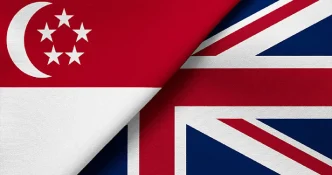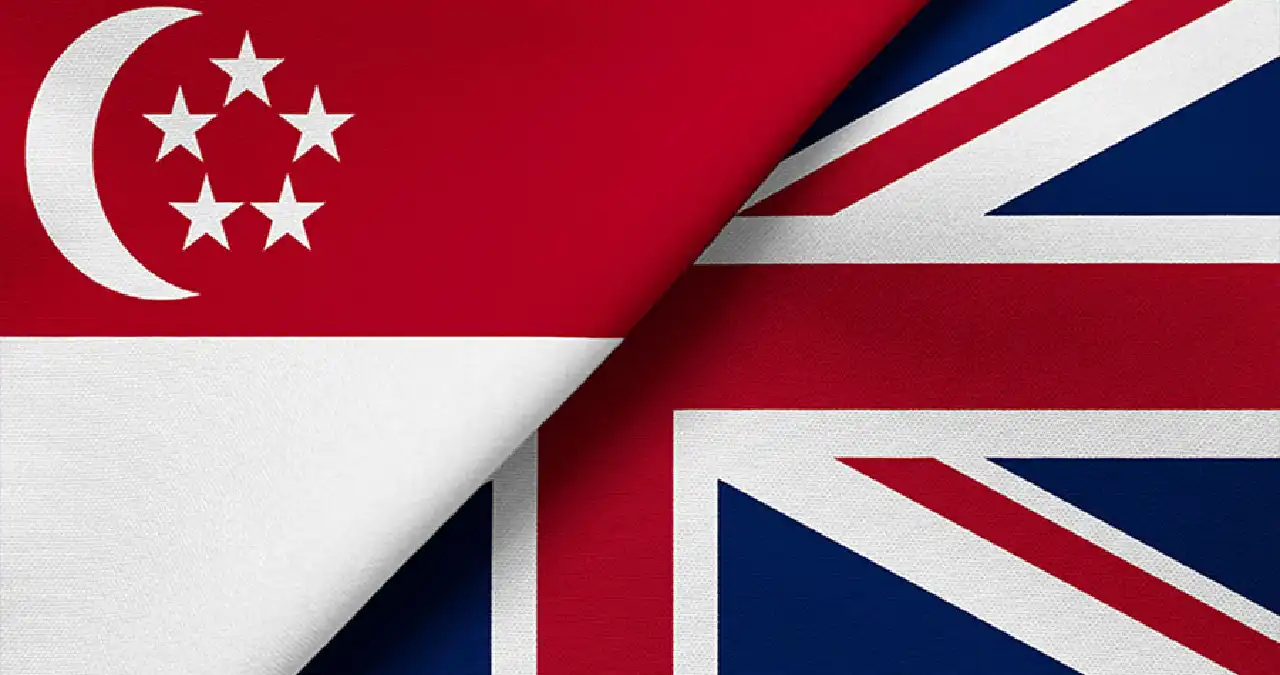Singapore and the United Kingdom are forging a deeper partnership, focusing on trade, defense, and technological innovation, as global geopolitical tensions and economic challenges loom large. British Secretary of State for Science, Innovation and Technology Peter Kyle, during a recent visit to Singapore, underscored the significance of this relationship, describing the city-state as a vital gateway to the Indo-Pacific—a region where Britain seeks to expand its influence.
Symbolic Milestones in Bilateral Relations
The visit coincided with a historic moment for Singapore-UK ties, as the HMS Prince of Wales, a British aircraft carrier, made its first formal port call at the Marina Bay Cruise Centre. The carrier is part of an eight-month Indo-Pacific deployment, symbolizing six decades of shared history and mutual interests between the two nations. “It is a real milestone. (These) 60 years we have communicated, built diplomatic relations, traded together” said Mr. Kyle, reflecting on the longstanding collaboration that has tackled challenges and created opportunities.
The port call is more than ceremonial. The HMS Prince of Wales leads a strike group involving ships, aircraft, and personnel from 30 countries, including the United States, India, Singapore, and Malaysia. This multinational deployment, spanning the Mediterranean, Middle East, and Indo-Pacific, underscores a collective commitment to regional stability at a time of heightened uncertainty. Mr. Kyle described the mission as a “friendly” endeavor among like-minded nations, aimed at delivering “peace and stability” to foster trade and diplomatic relations.
Trade and Technology: Pillars of Future Collaboration
Beyond defense, economic and technological partnerships are at the heart of this renewed engagement. Mr. Kyle highlighted Singapore’s role as a hub for Britain’s ambitions in the Indo-Pacific, a region characterized by rapid growth and innovation. “The fast-growing sectors of the future—we look at space, AI (artificial intelligence), automation, drone technology. All of these areas are things that Britain … Singapore and the (surrounding) area (are) very good at” he said, emphasizing the potential for closer cooperation to seize emerging opportunities.
Singapore’s advancements in digital transformation were a particular point of admiration. Mr. Kyle noted that the city-state has “really led the world” in using digital technology to enhance governance and service delivery, an area where Britain seeks to learn and adapt. “The future lies in cooperation and collaboration fit for the digital age, not just the manufacturing age that we’ve been living in for the last 60 years” he said. This focus on digital innovation aligns with broader goals to address shared societal challenges, such as aging populations, which both nations face. Knowledge exchange on governance and policy responses to demographic shifts could yield mutual benefits, according to the British secretary.
Britain’s economic interest in the Indo-Pacific is clear. As a consumer and producer of goods and innovation, the UK aims to become a “solid economic partner” in a region poised for significant growth. “Where there is opportunity for economic growth, we want to be part of that. I think that the two go hand-in-hand” Mr. Kyle said, linking economic collaboration with the pursuit of peaceful diplomacy.
Defense and Diplomacy in a Tense Global Landscape
The timing of the HMS Prince of Wales deployment is notable, coming amid escalating geopolitical tensions, particularly in the Middle East. Mr. Kyle reiterated Britain’s commitment to de-escalation and diplomatic solutions in conflict zones. On the issue of Iran’s potential nuclear ambitions, he was unequivocal: “The (British) government is clear that it would be wrong for Iran to develop nuclear weapons. But we are part of a group of nations trying to de-escalate the tensions in the region. We are supportive of diplomatic progress” he said. Britain, alongside its allies, continues to leverage its influence to prioritize long-term diplomatic resolutions over military escalation.
Closer to the Indo-Pacific, the strike group’s presence sends a message of solidarity and strength. Mr. Kyle framed the mission as one with a purpose: to create an environment where prosperity can flourish through stability. “Peace has a purpose, and that’s in that environment, we can trade, have friendly diplomatic relations, and our people can explore opportunities together” he said. This vision aligns with Britain’s broader strategy to balance security interests with economic ambitions in the region.
Shared Values and Complementary Strengths
The foundation of Singapore-UK relations lies in shared values and complementary strengths, a theme Mr. Kyle returned to repeatedly during his visit. Over the past six decades, the two nations have built a partnership rooted in mutual respect and a commitment to addressing global challenges collaboratively. Whether through diplomatic channels or economic initiatives, this relationship has proven resilient, adapting to changing international dynamics.
Singapore’s strategic position as a gateway to the Indo-Pacific enhances its importance to Britain’s foreign policy. The region, encompassing some of the world’s fastest-growing economies, offers immense potential for trade and investment. For Britain, post-Brexit, strengthening ties with dynamic markets like Singapore is a priority, providing access to broader Asian markets while reinforcing its global standing as a leader in innovation and technology.
Defense cooperation, too, plays a critical role. Joint exercises and operations, such as those involving the HMS Prince of Wales strike group, demonstrate a shared commitment to maintaining a rules-based international order. Singapore’s participation in these initiatives reflects its own interest in regional stability, particularly in the South China Sea, where territorial disputes and great power rivalries continue to simmer. While Mr. Kyle did not directly address specific regional conflicts, his emphasis on de-escalation and diplomacy suggests a cautious approach to navigating these complex issues.
Looking Ahead: Challenges and Opportunities
As Singapore and Britain chart the next chapter of their partnership, several challenges loom on the horizon. Global economic uncertainties, driven by inflation, supply chain disruptions, and geopolitical conflicts, could test the resilience of their trade ties. Both nations will need to navigate these headwinds while capitalizing on opportunities in emerging sectors like artificial intelligence and space technology. If successful, their collaboration could set a precedent for how smaller, innovation-driven economies partner with larger powers in an increasingly interconnected world.
Demographic challenges, particularly aging populations, present another area for joint action. Singapore’s proactive policies—ranging from healthcare innovations to workforce retraining—offer valuable lessons for Britain, which grapples with similar issues. Conversely, Britain’s experience in social welfare systems could inform Singapore’s approach to balancing economic growth with social equity. This mutual learning process, as Mr. Kyle noted, is a cornerstone of their evolving relationship.
Geopolitically, the Indo-Pacific remains a region of strategic importance and contention. Britain’s increased engagement, through deployments like the HMS Prince of Wales and initiatives such as the AUKUS pact with Australia and the United States, signals a shift toward a more active role in Asia. For Singapore, maintaining its position as a neutral, trade-focused hub while deepening ties with Western allies requires careful diplomacy. The city-state’s ability to balance these relationships will be crucial in sustaining its relevance as a gateway to the region.
A Partnership for the Future
The visit of Mr. Kyle and the docking of the HMS Prince of Wales mark a significant moment in Singapore-UK relations, reflecting a shared vision for a stable, prosperous future. As global uncertainties persist, from conflicts in the Middle East to economic volatility, the partnership between these two nations offers a model of collaboration grounded in dialogue and mutual benefit. With a focus on cutting-edge industries and diplomatic engagement, their alliance is poised to address the challenges of the 21st century.
As both countries look ahead, the question remains how they will adapt their cooperation to a rapidly changing world. Will technology and trade prove sufficient to bridge geopolitical divides, or will new tensions test the strength of their six-decade bond? For now, the commitment to peace, prosperity, and innovation stands as a promising foundation for what lies ahead.
















